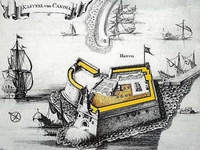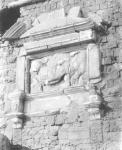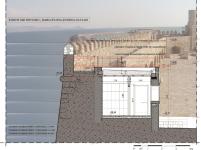

In the early 20ies, interventions occurred on
the upper terrace of the fortress, aiming to rearrange the auxiliary buildings
into rooms for the accommodation of the lighthouse keeper and the Sea
Scouts. Around 1920 the “Committee for
the Harbor of Heraklion” installed on the upper terrace power
poles and a crane, which collapsed during the W.W. II bombardments. At that
period, the NE side of the Fortress had been undercut by the sea-weaves. The
problem was solved when the extension of the NW breakwater was
constructed.
The first restoration
campaign took place in 1959 under the supervision of the archaeologist
Stylianos Alexiou and included the demolition of the half-ruined Ottoman
battlements along with some modern constructions, the removal of the embankment
of the terrace, especially on the southern and eastern side, and the
restoration of some canon-openings. The demolition of the modern constructions
of the western and northern side of the terrace took place in 1969 under the
supervision of the archeologist Emmanuel Borboudakis, who also conducted a more
systematic restoration campaign between the years 1972-1975, according to an
official plan executed by the architect A. Lambakis. During the campaign, the
entire corridor of the battlements and the cannon-openings of the upper terrace
were restored, the terrace itself received a stone-pavement, skylight-windows
on stone-parapets were added, a facility-building was constructed at the
northern edge of the terrace, another building at the western edge was
rearranged to act as scenery background for the small open-air theater that was
installed and the facades of the southern buildings were reconstructed. The
vaulted chambers on the ground level were cleaned up of embankments and their
floors were covered with stone pavement; wooden doors and shutters for the
canon-openings were added as well as electricity, water and drainage
installations. The southern facade of the fortress was also restored and the access
to the Venetian and modern breakwater was improved.
In 2002 the 13th Ephorate of Byzantine Antiquities restored
parts of the battlements’ parapet. In 2007 the undercuts (or perhaps underwater
canals) were restored by “Heraklion Port Authority S.A.” according to a plan
executed by the “Eastern Crete Development Organization”.
 | 2. The Sea-Rock (La Rocca a Mare) | |
|---|---|---|
 | 2.1 Sea-Fortress. The history of the construction | |
 | 2.2 The relief emblems of Venice | |
 | 2.4 The recent restoration campaign (2011-2016) |